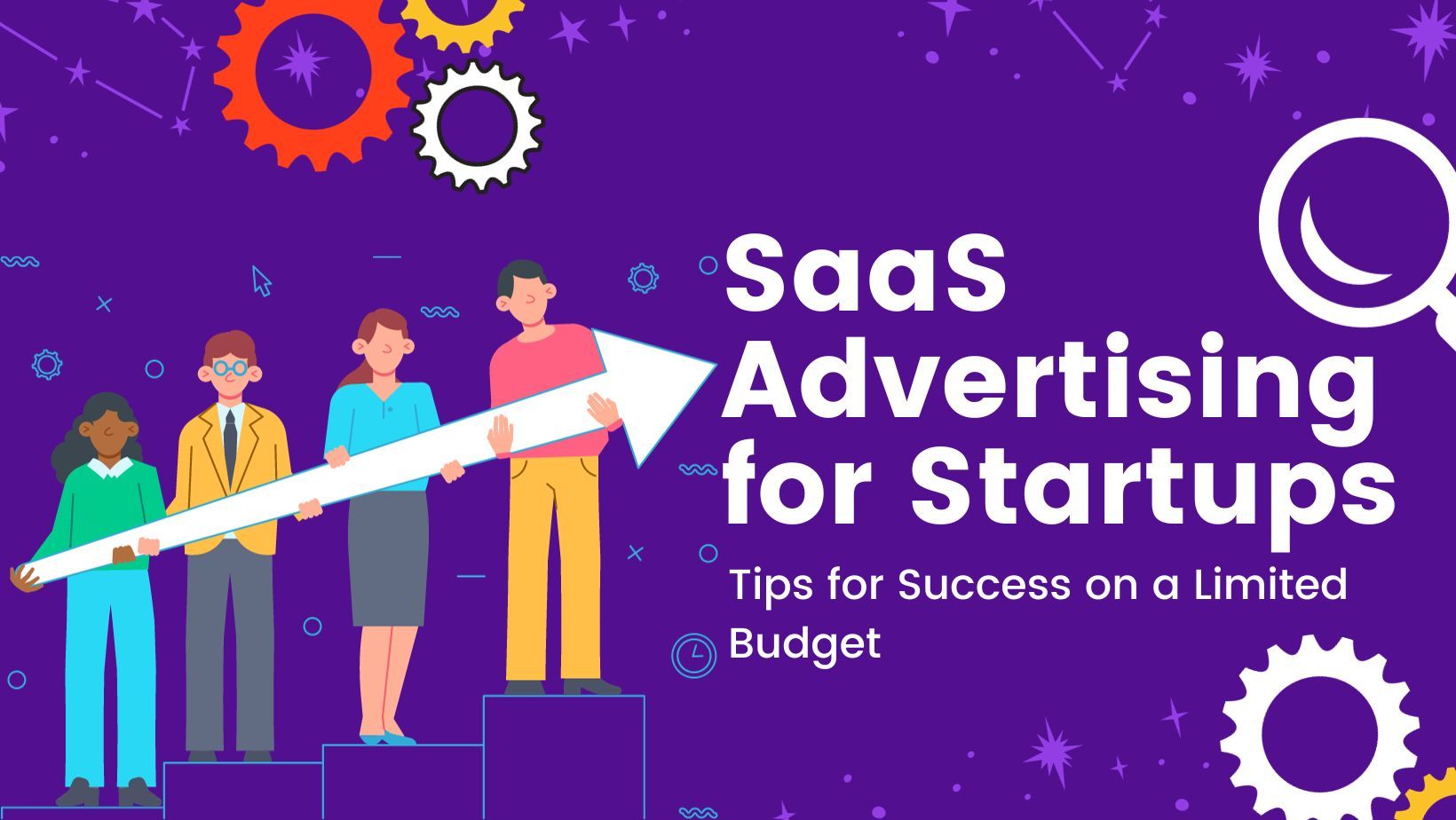SaaS Advertising for Startups: Tips for Success on a Limited Budget

Launching a SaaS startup is an exciting journey filled with potential, but it also comes with its challenges. One of the biggest challenges is advertising. How do you effectively get the word out about your product, especially when you're operating on a tight budget? Let’s dive in.
1) Know Your Audience
Getting to know your target audience is the first and most crucial step in building your
SaaS advertising strategy. When you truly understand the people you want to reach, your messages resonate better, and your ad dollars are spent more wisely.
Start by asking these key questions:
- Who are they? Get a clear picture of their demographics - age, gender, location, and occupation.
- What problems do they face? Your SaaS solution should be the answer they’ve been looking for.
- Where do they spend their time online? Whether it's LinkedIn for professionals, Instagram for younger demographics, or specialized forums related to your industry, knowing this will help you decide where to concentrate your efforts.
- When are they most active? Timing your ads or posts during their peak online hours can increase engagement.
- Why would they opt for your SaaS products? Understand their motivations. Are they looking for efficiency, affordability, or perhaps innovation?
2) Use Organic Social Media
Organic social media allows you to create a strong online presence, build a loyal community, and reach potential users—all without spending on ads. Here's a detailed guide on making the most of this powerful tool:
- Stay Consistent with Posts: Create a regular posting schedule. Whether you choose to post daily, weekly, or bi-weekly, consistency keeps your brand at the forefront of your audience's mind.
- Engage Authentically: Respond to comments, answer questions, and engage in discussions related to your industry. By doing so, you not only foster trust but also understand your audience’s needs more deeply.
- Maximize Hashtags: Use relevant hashtags to cast a wider net. Research trending and industry-specific hashtags to ensure your posts get maximum visibility.
- Share Stories: Platforms like Instagram and Facebook have a 'Stories' feature, which is excellent for sharing behind-the-scenes content, quick updates, or user testimonials.
- Collaborate with Influencers: Partner with micro-influencers in your industry. They often have a dedicated following and can introduce your product to a larger audience organically.
- Host Live Sessions: Go live on platforms like Instagram or Facebook to discuss your product, share updates, or host Q&A sessions. It's an immediate way to connect and engage.
- Engage in Relevant Groups: Join and participate in groups or forums related to your industry. Share your insights, answer queries, and subtly introduce your SaaS solution where relevant.
3) Create Valuable Content
In the digital world, content isn’t just king—it’s the entire kingdom. High-quality content positions your SaaS startup as a trusted authority in the industry. It attracts potential customers, engages existing ones, and turns your website into a valuable resource.
Here’s how to craft content that not only captures attention but also drives action:
- Identify Pain Points: Begin by understanding the challenges your target audience faces. Your content should offer solutions, hints, and guidance on these specific issues, making your SaaS product a clear solution.
- Diversify Your Formats: Don't restrict yourself to just blog posts. Explore infographics, videos, podcasts, and webinars. Different people prefer different content formats, so cater to a broader audience by mixing it up.
- Prioritize Quality Over Quantity: It's better to produce one in-depth, well-researched piece every week than to churn out daily content that lacks depth. Quality content gets shared more often, increasing its reach.
- Optimize for Search Engines (SEO): Ensure that your content is optimized for search engines. Use relevant keywords naturally, include meta descriptions, and utilize header tags to make it both user and search-engine friendly.
- Stay Updated: The tech world moves fast. Regularly update your content to reflect industry changes, new features of your product, or any recent data that can add value.
- Engage with Your Audience: Don't just post and forget. Similar to social media posts, engage with comments, gather feedback, and ask questions. It will give you insights into what your audience wants to read about next.
- Repurpose Content: Turn a popular blog post into a video or an infographic into a series of social media posts. This maximizes the lifespan of your content and reaches different audience segments.
4) Leverage Email Marketing
Email marketing remains one of the most effective tools in a startup's arsenal. It offers a direct line of communication to your audience, allowing you to nurture relationships, share updates, and drive conversions. With a bit of planning and strategy, you can turn your email campaigns into powerful connectors.
Here's how to make every email count:
- Build a Solid List: It all starts here. Encourage sign-ups on your website, offering valuable resources, like e-books or webinars, in exchange. Remember, quality over quantity: it's better to have a smaller, engaged list than a large, disinterested one.
- Segment Your Audience: Not all subscribers are the same. Segment your list based on user behavior, purchase history, or how they signed up. Tailored messages resonate better and lead to higher engagement.
- Craft Engaging Subject Lines: Your subject line decides if an email gets opened. Make it intriguing, relevant, and concise. A/B test different lines to find what works best.
- Offer Real Value: Whether it's a monthly newsletter or special offers, ensure that every email offers something beneficial. Don't just sell; educate, inform, and entertain.
- Optimize Send Times: Study your audience to find the best times to send emails. Often, this is when they're most likely to read and engage. Tools can help automate this process, sending emails at optimal times for each subscriber.
- Use Clear Calls-to-Action (CTAs): Decide what you want the reader to do next and make it clear. Whether it's "Learn More," "Shop Now," or "Join Us," a compelling CTA can drive action.
- Monitor and Analyze: Use tools to track open rates, click-through rates, and conversions. This data will offer insights into what's working and where improvements are needed.
5) Take Advantage of Free Advertising Credits
The journey of advertising for startups often begins with limited funds. However, several online advertising platforms understand this hurdle and offer a leg up in the form of free advertising credits. These credits can be a game-changer, providing you with a risk-free way to test and refine your advertising strategies.
Here's how to harness these opportunities to their fullest:
- Discover Available Offers: Major platforms like Google Ads, Bing Ads, and Facebook Ads frequently provide promotional credits to new advertisers. Keep an eye out for these opportunities, especially during special promotional periods or partnerships with web hosting services.
- Test and Learn: Use these free credits as a learning experience. Experiment with different ad types, target audiences, and keywords to see what yields the best results. Remember, this is your chance to make mistakes without financial repercussions.
- Optimize Your Landing Pages: Before launching your ads, ensure that the pages you're driving traffic to are well-optimized. A compelling ad is only half the battle; you need a landing page that converts that interest into action.
- Set Clear Objectives: Before diving in, be clear about what you want to achieve. Whether it's brand awareness, website visits, or conversions, having a clear goal will guide your campaign strategies.
- Monitor Performance Religiously: Regularly check how your ads are performing. Platforms usually offer detailed analytics, giving insights into metrics like click-through rates, conversions, and engagement.
- Plan Your Next Steps: If you find success with your free credits, plan out how you might allocate a budget for future paid advertising. Being prepared can help seamlessly transition from free credits to a self-funded campaign.
6) Offer Freemium or Trials
One of the most effective strategies for
SaaS startups to gain traction and trust is through offering freemium versions or trial periods of their products. This approach not only provides potential customers with a firsthand experience of your product's value but also paves the way for converting them into paying users.
Let’s delve deeper into how to effectively leverage this model for optimal results:
- Showcase Core Features: In a freemium model or trial period, ensure that users experience the essential features of your software. This gives them a clear understanding of its capabilities and how it can address their needs.
- Limit Advanced Features: While you want to provide a solid experience, it's essential to keep some advanced or premium features behind a paywall. This creates an incentive for users to upgrade.
- Simplify Sign-Up Process: Make it easy for potential customers to start their trial or access the freemium version. The fewer barriers there are, the more likely users will give your product a chance.
- Educate Your Users: Offering guides, tutorials, and webinars can help users maximize the benefits during their trial period. When they see the full potential of your software, they're more likely to become paying customers.
- Gather Feedback: Use the trial period as an opportunity to gather feedback. Understand what users love, what they feel is lacking, and where improvements can be made. This not only helps in product development but also shows users that you value their input.
- Send Timely Reminders: If your trial has a time limit, send reminders as the end date approaches. Highlight the benefits of upgrading and any special offers that might be available.
- Offer Seamless Transition: If users decide to upgrade, ensure the transition from trial or freemium to a paid plan is smooth. Retain their settings, preferences, and any data they might have input.
- Analyze Drop-offs: Monitor at what stage trial users or freemium users drop off without converting. This can provide valuable insights into potential friction points or areas of improvement.
Summary
Advertising your
SaaS startup on a limited budget might seem challenging, but with the right strategies, you can achieve great results. Focus on your target audience, create valuable content, and always adjust your tactics based on feedback. With dedication and persistence, your SaaS business can thrive even on a shoestring budget.
Looking to amplify your SaaS startup's reach without breaking the bank? Falconics, your SaaS marketing ally, turns limited budgets into limitless possibilities. Contact us today for more information about our services!




